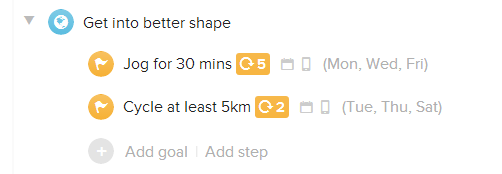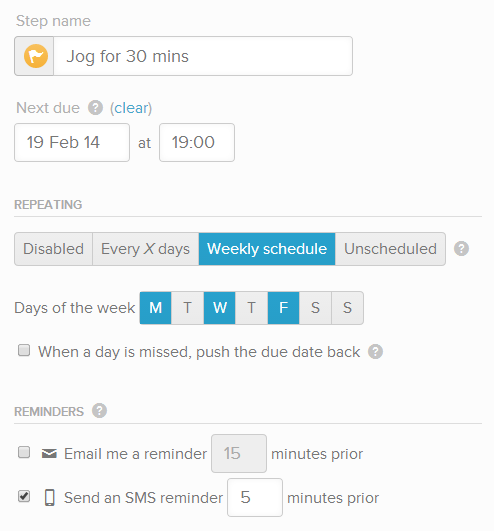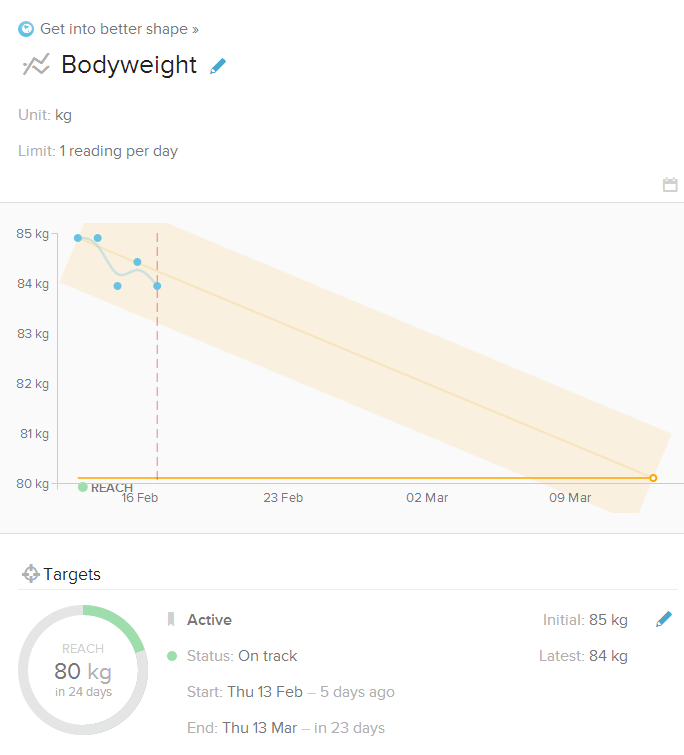Help › Examples › Losing weight
If done incorrectly, trying to lose weight can become a tiring and disappointing experience as it drags on and on without any visible results. This example contains some ideas on how you can be smart and efficient about the process, with measurable results.
- Features Repeating Steps, Notes, Attachments, Trackers, Targets
Create an exercise routine
One of the biggest factors of weight loss is making sure you're living a consistently healthy and active lifestyle. On top of making generally healthy lifestyle choices (e.g. lots of walking, not spending all day sedentary), it's helpful to build up a routine of reasonably high intensity cardio exercises.
Pick a few aerobic exercises (such as jogging, cycling, or running on a treadmill), and build up a weekly routine using the Weekly schedule option when setting up a step. To make sure you can't forget, choose a time of day, and set up email or SMS reminders.
Keep your to-do list up-to-date when you exercise (add the app to your phone's home screen so you can do this anywhere), and you'll be able to use the streaks (5) to get an idea of how well you're sticking to your routine.
Remember to review your routine every couple of weeks or so, and think about how it can be improved if it isn't giving you the desired results.


Track your progress
Use the Notes and Attachments section of the timeline to keep track of your progress over time. Write notes about progress you've noticed or how your feel, and use the attachments section to upload the occasional photo of your progress. This way you'll be able to quickly look back in time and remind yourself of the progress you've already made.
Even better is if you can start tracking something that can be quantified - a great candidate here being your bodyweight. Click Add a tracker from the menu () on the goal's page, and set a tracker up for your bodyweight. Then add a [Reach] Decrease to target for the weight you're aiming to reach, with a realistic time period. You'll now be able to regularly check up on your progress, and see if you're staying on track.

Cut down on calories
Whilst cutting down on known unhealthy foods (e.g. those high in fat or sugar) are great decisions for overall health, the most important input towards bodyweight and excess bodyfat is calories. Calculate your total daily energy expenditure (TDEE), and then pick a daily calorie limit a few hundred calories below.
Set up another tracker, this time for the number of calories consumed each day. And set up a target of [Sustain] No more than. The most convenient long-term solution may be to set up a new target at the beginning of every week, so that you have a fresh start to try and stick to. Try to keep count of the calories you consume throughout the day, and keep your readings regularly updated. But if you forget to add a day's reading, you can always go back and add that reading later.
Even if you're using a more specific app to track calories at individual meals, it's still worth keeping a top-level eye on your progress with Nach (e.g. a daily calorie reading), so you can keep a holistic view on long-term progress alongside your other goals.

